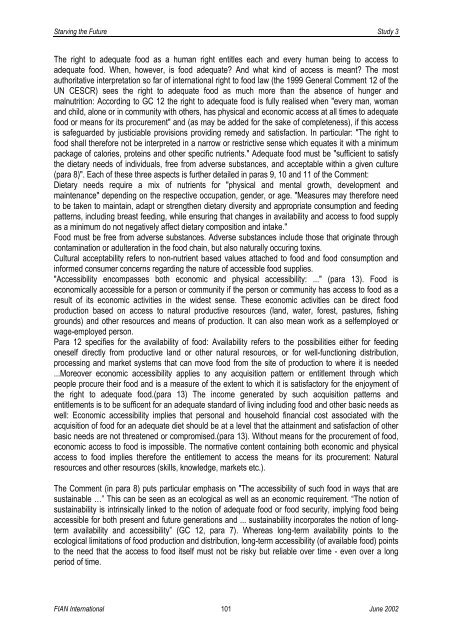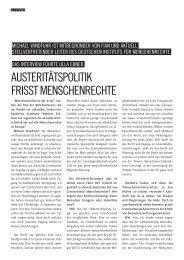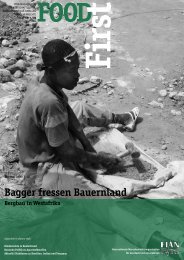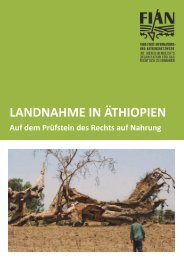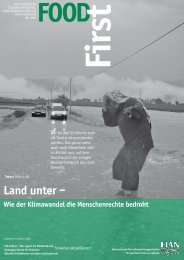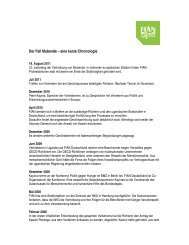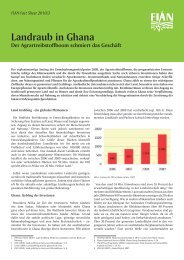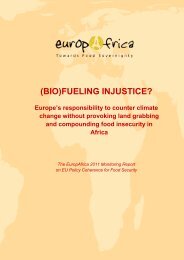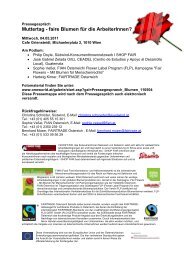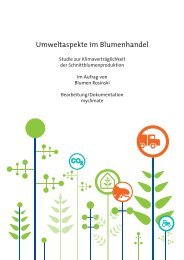Study 3: Ecodestruction and the Right to Food: The Cases of Water ...
Study 3: Ecodestruction and the Right to Food: The Cases of Water ...
Study 3: Ecodestruction and the Right to Food: The Cases of Water ...
Create successful ePaper yourself
Turn your PDF publications into a flip-book with our unique Google optimized e-Paper software.
Starving <strong>the</strong> Future <strong>Study</strong> 3<br />
<strong>The</strong> right <strong>to</strong> adequate food as a human right entitles each <strong>and</strong> every human being <strong>to</strong> access <strong>to</strong><br />
adequate food. When, however, is food adequate? And what kind <strong>of</strong> access is meant? <strong>The</strong> most<br />
authoritative interpretation so far <strong>of</strong> international right <strong>to</strong> food law (<strong>the</strong> 1999 General Comment 12 <strong>of</strong> <strong>the</strong><br />
UN CESCR) sees <strong>the</strong> right <strong>to</strong> adequate food as much more than <strong>the</strong> absence <strong>of</strong> hunger <strong>and</strong><br />
malnutrition: According <strong>to</strong> GC 12 <strong>the</strong> right <strong>to</strong> adequate food is fully realised when "every man, woman<br />
<strong>and</strong> child, alone or in community with o<strong>the</strong>rs, has physical <strong>and</strong> economic access at all times <strong>to</strong> adequate<br />
food or means for its procurement" <strong>and</strong> (as may be added for <strong>the</strong> sake <strong>of</strong> completeness), if this access<br />
is safeguarded by justiciable provisions providing remedy <strong>and</strong> satisfaction. In particular: "<strong>The</strong> right <strong>to</strong><br />
food shall <strong>the</strong>refore not be interpreted in a narrow or restrictive sense which equates it with a minimum<br />
package <strong>of</strong> calories, proteins <strong>and</strong> o<strong>the</strong>r specific nutrients." Adequate food must be "sufficient <strong>to</strong> satisfy<br />
<strong>the</strong> dietary needs <strong>of</strong> individuals, free from adverse substances, <strong>and</strong> acceptable within a given culture<br />
(para 8)". Each <strong>of</strong> <strong>the</strong>se three aspects is fur<strong>the</strong>r detailed in paras 9, 10 <strong>and</strong> 11 <strong>of</strong> <strong>the</strong> Comment:<br />
Dietary needs require a mix <strong>of</strong> nutrients for "physical <strong>and</strong> mental growth, development <strong>and</strong><br />
maintenance" depending on <strong>the</strong> respective occupation, gender, or age. "Measures may <strong>the</strong>refore need<br />
<strong>to</strong> be taken <strong>to</strong> maintain, adapt or streng<strong>the</strong>n dietary diversity <strong>and</strong> appropriate consumption <strong>and</strong> feeding<br />
patterns, including breast feeding, while ensuring that changes in availability <strong>and</strong> access <strong>to</strong> food supply<br />
as a minimum do not negatively affect dietary composition <strong>and</strong> intake."<br />
<strong>Food</strong> must be free from adverse substances. Adverse substances include those that originate through<br />
contamination or adulteration in <strong>the</strong> food chain, but also naturally occuring <strong>to</strong>xins.<br />
Cultural acceptability refers <strong>to</strong> non-nutrient based values attached <strong>to</strong> food <strong>and</strong> food consumption <strong>and</strong><br />
informed consumer concerns regarding <strong>the</strong> nature <strong>of</strong> accessible food supplies.<br />
"Accessibility encompasses both economic <strong>and</strong> physical accessibility: ..." (para 13). <strong>Food</strong> is<br />
economically accessible for a person or community if <strong>the</strong> person or community has access <strong>to</strong> food as a<br />
result <strong>of</strong> its economic activities in <strong>the</strong> widest sense. <strong>The</strong>se economic activities can be direct food<br />
production based on access <strong>to</strong> natural productive resources (l<strong>and</strong>, water, forest, pastures, fishing<br />
grounds) <strong>and</strong> o<strong>the</strong>r resources <strong>and</strong> means <strong>of</strong> production. It can also mean work as a selfemployed or<br />
wage-employed person.<br />
Para 12 specifies for <strong>the</strong> availability <strong>of</strong> food: Availability refers <strong>to</strong> <strong>the</strong> possibilities ei<strong>the</strong>r for feeding<br />
oneself directly from productive l<strong>and</strong> or o<strong>the</strong>r natural resources, or for well-functioning distribution,<br />
processing <strong>and</strong> market systems that can move food from <strong>the</strong> site <strong>of</strong> production <strong>to</strong> where it is needed<br />
...Moreover economic accessibility applies <strong>to</strong> any acquisition pattern or entitlement through which<br />
people procure <strong>the</strong>ir food <strong>and</strong> is a measure <strong>of</strong> <strong>the</strong> extent <strong>to</strong> which it is satisfac<strong>to</strong>ry for <strong>the</strong> enjoyment <strong>of</strong><br />
<strong>the</strong> right <strong>to</strong> adequate food.(para 13) <strong>The</strong> income generated by such acquisition patterns <strong>and</strong><br />
entitlements is <strong>to</strong> be sufficent for an adequate st<strong>and</strong>ard <strong>of</strong> living including food <strong>and</strong> o<strong>the</strong>r basic needs as<br />
well: Economic accessibility implies that personal <strong>and</strong> household financial cost associated with <strong>the</strong><br />
acquisition <strong>of</strong> food for an adequate diet should be at a level that <strong>the</strong> attainment <strong>and</strong> satisfaction <strong>of</strong> o<strong>the</strong>r<br />
basic needs are not threatened or compromised.(para 13). Without means for <strong>the</strong> procurement <strong>of</strong> food,<br />
economic access <strong>to</strong> food is impossible. <strong>The</strong> normative content containing both economic <strong>and</strong> physical<br />
access <strong>to</strong> food implies <strong>the</strong>refore <strong>the</strong> entitlement <strong>to</strong> access <strong>the</strong> means for its procurement: Natural<br />
resources <strong>and</strong> o<strong>the</strong>r resources (skills, knowledge, markets etc.).<br />
<strong>The</strong> Comment (in para 8) puts particular emphasis on "<strong>The</strong> accessibility <strong>of</strong> such food in ways that are<br />
sustainable …” This can be seen as an ecological as well as an economic requirement. “<strong>The</strong> notion <strong>of</strong><br />
sustainability is intrinsically linked <strong>to</strong> <strong>the</strong> notion <strong>of</strong> adequate food or food security, implying food being<br />
accessible for both present <strong>and</strong> future generations <strong>and</strong> ... sustainability incorporates <strong>the</strong> notion <strong>of</strong> longterm<br />
availability <strong>and</strong> accessibility” (GC 12, para 7). Whereas long-term availability points <strong>to</strong> <strong>the</strong><br />
ecological limitations <strong>of</strong> food production <strong>and</strong> distribution, long-term accessibility (<strong>of</strong> available food) points<br />
<strong>to</strong> <strong>the</strong> need that <strong>the</strong> access <strong>to</strong> food itself must not be risky but reliable over time - even over a long<br />
period <strong>of</strong> time.<br />
FIAN International 101<br />
June 2002


